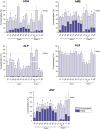In vitro interactions of Alternaria mycotoxins, an emerging class of food contaminants, with the gut microbiota: a bidirectional relationship
- PMID: 33847775
- PMCID: PMC8241668
- DOI: 10.1007/s00204-021-03043-x
In vitro interactions of Alternaria mycotoxins, an emerging class of food contaminants, with the gut microbiota: a bidirectional relationship
Abstract
The human gut microbiota plays an important role in the maintenance of human health. Factors able to modify its composition might predispose the host to the development of pathologies. Among the various xenobiotics introduced through the diet, Alternaria mycotoxins are speculated to represent a threat for human health. However, limited data are currently available about the bidirectional relation between gut microbiota and Alternaria mycotoxins. In the present work, we investigated the in vitro effects of different concentrations of a complex extract of Alternaria mycotoxins (CE; containing eleven mycotoxins; e.g. 0.153 µM alternariol and 2.3 µM altersetin, at the maximum CE concentration tested) on human gut bacterial strains, as well as the ability of the latter to metabolize or adsorb these compounds. Results from the minimum inhibitory concentration assay showed the scarce ability of CE to inhibit the growth of the tested strains. However, the growth kinetics of most of the strains were negatively affected by exposure to the various CE concentrations, mainly at the highest dose (50 µg/mL). The CE was also found to antagonize the formation of biofilms, already at concentrations of 0.5 µg/mL. LC-MS/MS data analysis of the mycotoxin concentrations found in bacterial pellets and supernatants after 24 h incubation showed the ability of bacterial strains to adsorb some Alternaria mycotoxins, especially the key toxins alternariol, alternariol monomethyl ether, and altersetin. The tendency of these mycotoxins to accumulate within bacterial pellets, especially in those of Gram-negative strains, was found to be directly related to their lipophilicity.
Keywords: Adsorption; Biofilm; Chemical mixture; Lipophilicity; Microbiome.
Conflict of interest statement
The authors declare no conflict of interest.
Figures






Similar articles
-
Gut microbiota and undigested food constituents modify toxin composition and suppress the genotoxicity of a naturally occurring mixture of Alternaria toxins in vitro.Arch Toxicol. 2020 Oct;94(10):3541-3552. doi: 10.1007/s00204-020-02831-1. Epub 2020 Jul 4. Arch Toxicol. 2020. PMID: 32623606 Free PMC article.
-
Analysis of 13 Alternaria mycotoxins including modified forms in beer.Mycotoxin Res. 2021 May;37(2):149-159. doi: 10.1007/s12550-021-00424-0. Epub 2021 Mar 5. Mycotoxin Res. 2021. PMID: 33666860 Free PMC article.
-
Development and Validation of a LC-ESI-MS/MS Method for the Determination of Alternaria Toxins Alternariol, Alternariol Methyl-Ether and Tentoxin in Tomato and Tomato-Based Products.Toxins (Basel). 2016 Nov 11;8(11):328. doi: 10.3390/toxins8110328. Toxins (Basel). 2016. PMID: 27845716 Free PMC article.
-
Alternaria toxins-Still emerging?Compr Rev Food Sci Food Saf. 2021 Sep;20(5):4390-4406. doi: 10.1111/1541-4337.12803. Epub 2021 Jul 29. Compr Rev Food Sci Food Saf. 2021. PMID: 34323368 Review.
-
Recent developments in stable isotope dilution assays in mycotoxin analysis with special regard to Alternaria toxins.Anal Bioanal Chem. 2015 Oct;407(25):7563-77. doi: 10.1007/s00216-015-8904-y. Epub 2015 Aug 12. Anal Bioanal Chem. 2015. PMID: 26265031 Review.
Cited by
-
Multimodal interactions of drugs, natural compounds and pollutants with the gut microbiota.Nat Rev Microbiol. 2022 Jul;20(7):431-443. doi: 10.1038/s41579-022-00681-5. Epub 2022 Jan 31. Nat Rev Microbiol. 2022. PMID: 35102308 Free PMC article. Review.
-
Effect of Dietary Difructose Anhydride III Supplementation on the Metabolic Profile of Japanese Black Breeding Herds with Low-Level Chronic Exposure to Zearalenone in the Dietary Feed.Toxins (Basel). 2025 Aug 14;17(8):409. doi: 10.3390/toxins17080409. Toxins (Basel). 2025. PMID: 40864085 Free PMC article.
-
Natural Dibenzo-α-Pyrones: Friends or Foes?Int J Mol Sci. 2021 Dec 2;22(23):13063. doi: 10.3390/ijms222313063. Int J Mol Sci. 2021. PMID: 34884865 Free PMC article. Review.
-
Tenuazonic acid alters immune and physiological reactions and susceptibility to pathogens in Galleria mellonella larvae.Mycotoxin Res. 2023 May;39(2):135-149. doi: 10.1007/s12550-023-00479-1. Epub 2023 Apr 18. Mycotoxin Res. 2023. PMID: 37071305
-
Occurrence, toxicity, dietary exposure, and management of Alternaria mycotoxins in food and feed: A systematic literature review.Compr Rev Food Sci Food Saf. 2025 Jan;24(1):e70085. doi: 10.1111/1541-4337.70085. Compr Rev Food Sci Food Saf. 2025. PMID: 39746866 Free PMC article.
References
-
- Baines D, Sumarah M, Kuldau G, et al. Aflatoxin, fumonisin and Shiga toxin-producing Escherichia coli infections in calves and the effectiveness of celmanax®/dairyman’s choiceTM applications to eliminate morbidity and mortality losses. Toxins (Basel) 2013;5:1872–1895. doi: 10.3390/toxins5101872. - DOI - PMC - PubMed
Publication types
MeSH terms
Substances
LinkOut - more resources
Full Text Sources
Other Literature Sources

